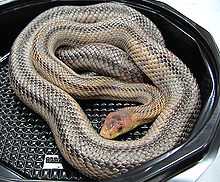Pantherophis bairdi
| Pantherophis bairdi | |
|---|---|
 | |
| Scientific classification | |
| Kingdom: | Animalia |
| Phylum: | Chordata |
| Subphylum: | Vertebrata |
| Class: | Reptilia |
| Order: | Squamata |
| Suborder: | Serpentes |
| Family: | Colubridae |
| Subfamily: | Colubrinae |
| Tribe: | Lampropeltini |
| Genus: | Pantherophis |
| Species: | P. bairdi |
| Binomial name | |
| Pantherophis bairdi (Yarrow, 1880) | |
| Synonyms | |
Pantherophis bairdi is a harmless colubrid snake species endemic to the southwestern United States and adjacent northeastern Mexico. No subspecies are currently recognized.[2]
Geographic range
It is found in the United States in the Big Bend region of western Texas, as well as in northern Mexico in the Mexican states of Coahuila, Nuevo León, and Tamaulipas. [1]
Etymology
The species was named in honor of the American zoologist Spencer Fullerton Baird.[4]
Description
Adults can reach 64 to 140 cm (25 to 55 in) in total length (body + tail). The dorsal color pattern consists of an orange-yellow to bright yellow, or a darker salmon ground color, overlaid with four stripes that run from the neck to the tail. The belly is generally gray to yellow, darkening near the tail.
Diet
The primary diet consists of rodents, although they will also prey on birds. Juveniles often eat lizards.
Behavior
They are typically more pleasantly tempered than other rat snake species.
Reproduction
They are oviparous, laying a clutch of up to 10 eggs that take about 3 months to hatch.
Habitat
P. bairdi prefers semi-arid, rocky habitats.
Common names
Baird's rat snake, Baird's ratsnake,[2] Baird's pilot snake, Baird's Coluber, Great Bend rat snake.[3]
Taxonomy
Pantherophis bairdi has sometimes been considered a subspecies of Pantherophis obsoletus, to which it is closely related.
This species has often been placed in the genus Elaphe, but recent phylogenetic analyses have resulted in its transfer to Pantherophis.[5][6][7]
References
- ↑ 1.0 1.1 The Reptile Database. www.reptile-database.org.
- ↑ 2.0 2.1 2.2 "Elaphe bairdi". Integrated Taxonomic Information System. Retrieved 29 November 2008.
- ↑ 3.0 3.1 Wright AH, Wright AA. 1957. Handbook of Snakes of the United States and Canada. 2 volumes. Ithaca & London: Comstock Publishing Associates. (7th printing, 1985). 1,105 pp. ISBN 0-8014-0463-0. (Elaphe bairdi, pp. 214-218 + Figure 67 + Map 24 on p. 235).
- ↑ Beolens B, Watkins M, Grayson M. 2011. The Eponym Dictionary of Reptiles. Baltimore: Johns Hopkins University Press. xiii + 296 pp. ISBN 978-1-4214-0135-5. (Pantherophis bairdi, p. 14).
- ↑ Utiger U, Helfenberger N, Schätti B, Schmidt C, Ruf M, Ziswiler V. 2002. Molecular Systematics and Phylogeny of Old and New World ratsnakes, Elaphe Auct., and related genera (Reptilia, Squamata, Colubridae). Russian Journal of Herpetology 9 (2): 105-124.
- ↑ Burbrink FT, Lawson R. 2007. How and when did Old World ratsnakes disperse into the New World? Molecular Phylogenetics and Evolution 43: 173-189.
- ↑ Pyron RA, Burbrink FT. 2009. Neogene diversification and taxonomic stability in the snake tribe Lampropeltini (Serpentes: Colubridae). Molecular Phylogenetics and Evolution 52: 524-529.
Further reading
- Behler JL, King FW. 1979. The Audubon Society Field Guide to North American Reptiles and Amphibians. New York: Knopf. 743 pp. ISBN 0-394-50824-6. (Elaphe obsoleta bairdi, p. 606 + Plate 509).
- Collins JT, Taggart TW. 2008. An alternative classification of the New World Rat Snakes (genus Pantherophis [Reptilia: Squamata: Colubridae]). Journal of Kansas Herpetology 26: 16-18.
- Conant R. 1975. A Field Guide to Reptiles and Amphibians of Eastern and Central North America, Second Edition. Boston: Houghton Mifflin. xviii + 429 pp. ISBN 0-395-19979-4 (hardcover), ISBN 0-395-19977-8 (paperback). (Elaphe obsoleta bairdi, p. 196 + Plate 28 + Map 149).
- Schmidt KP. 1941. Field Book of Snakes of the United States and Canada. New York: G.P. Putnam's Sons. 365 pp. (Elaphe bairdi, pp. 144-145, Figure 38).
- Smith HM, Brodie ED Jr. 1982. Reptiles of North America: A Guide to Field Identification. New York: Golden Press. 240 pp. ISBN 0-307-13666-3. (Elaphe obsoleta bairdi, p. 184).
- Stejneger L, Barbour T. 1917. A Check List of North American Amphibians and Reptiles. Cambridge, Massachusetts: Harvard University Press. 125 pp. (Elaphe bairdi, p. 82).
- Yarrow HC. 1880. In: Cope ED. 1880. On the Zoological Position of Texas. Bull. United States National Mus. (17): 1-51. (Coluber bairdi, sp. nov., p. 41).
External links
| Wikimedia Commons has media related to Pantherophis bairdi. |
- Pantherophis bairdi at the Reptarium.cz Reptile Database. Accessed 29 November 2008.
- Elaphe bairdi at Herps of Texas. Accessed 29 November 2008.
- Elaphe bairdi at Bowling Green State University Herp Lab. Accessed 29 November 2008.